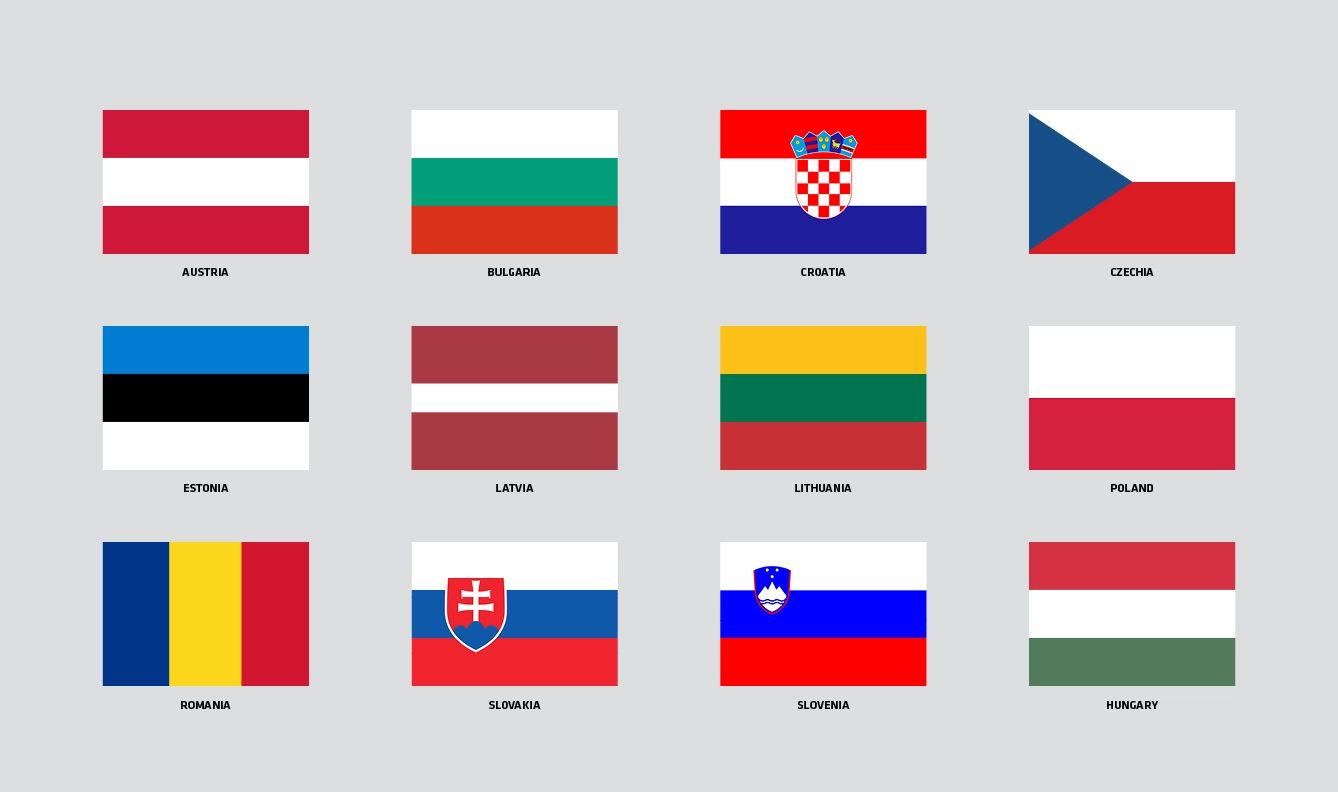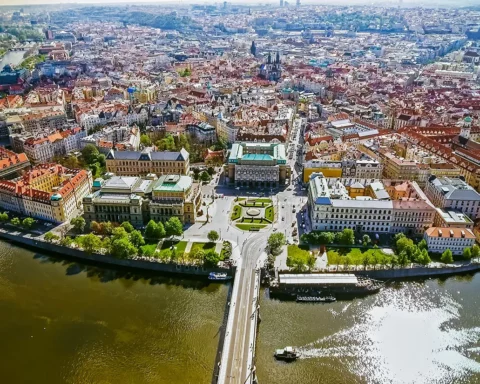Calling the Three Seas States Eastern European countries is an oversimplification. Perhaps it would be more precise to say they are located in Central and Eastern Europe. The Three Seas functions as an entity comprising separate nations whose histories are often intertwined and sometimes complicated and loaded with sensitive matters. Its countries proudly and eagerly share their heritage, rediscovering what they share rather than focusing on divisions.
Three Seas Initiative comprises 12 countries: Austria, Bulgaria, Croatia, Czechia, Estonia, Hungary, Latvia, Lithuania, Poland, Romania, Slovakia, and Slovenia. Some of the states regained their independence earlier than others. A flag and coat of arms have for centuries worked like a logo – an icon encapsulating the roots of a nation. What do central and Eastern European flags tell us?
Austria
The current flag was adopted in 1945, after the end of the Second World War. It is said to be one of the oldest flags still in contemporary use, representing the nation rather than the sovereign from the start. The colors represent strength and bravery (red), peace and honesty (white). The flag sometimes is presented with an eagle (in the past, a two-headed eagle). It symbolizes Austria’s sovereignty.
The crown on its head refers to the people of the middle class and pays tribute to their efforts in building the country. The eagle is holding a sickle (symbolic of the significant role agriculture has played in Austria’s history) and a hammer (referring to the industry and the mining history of the country). The broken chain was added to the eagle’s legs in 1945 and represented liberation from the National Socialist Dictatorship.
Bulgaria
Until the Ottoman Empire incorporated Bulgaria into its lands, the flag o the country was that of Tsar Ivan Shishman – a white flag with three red lions on a white shield. While the lion is still considered an important symbol of the country, the flag does not resemble the pre-Ottoman version in the least.
It was changed after the Russo-Turkish war when Bulgaria regained its independence (1879). The tri-color flag purposely resembles the Russian tri-color, as it emphasizes the unity of the Slavic nations (pan_Slavic colors) and the ethnic origins of Bulgarians.
Apart from that universal message, the colors used are not coincidental and have their meaning. Starting from the top: the white stands for freedom, peace, and love. The green refers to the pivotal role of agriculture in the country’s history. And the red symbolizes independence, struggle, and courage, especially in battle.
Croatia
Although Croatia’s route to independence was incredibly long and lasted for more than three centuries, the nation chose its colors to unite under despite the state did not exist in official terms. The red, white, and blue stripes correspond with the colors chosen by former, ancient realms – predecessors of today’s Croatia. The Kingdom of Croatia was united under the colors of white and red; the Kingdom of Slavonia used white and blue, while Dalmatia chose blue and yellow.
Out of these four colors – three common ones were chosen. In the center, you can see the Croatian coat of arms with a crown of five shields. The shields depict (from the left) the oldest known coat of arms of Croatia, the coat of arms of the Ragusa Republic, the coat of arms of Dalmatia, the coat of arms of Istria, and the coat of arms of Slavonia. The flag was officially adopted in December 1990, shortly before the Croatian War of Independence.
Czech Republic (Czechia)
The basis for contemporary Czechia’s flag can be found in the ancient Kingdom of Bohemia. Upon the formation of Czechoslovakia in 1918, the government decided that its flag would draw from the roots of the Bohemian flag. However, it would incorporate a blue triangle (apart from its symbolism, it was also very practical as it distinguished it from the flag of Poland).
The white stands for the virtues of peace and honesty, while the red corresponds with strength and courage (especially in battle). The blue triangle stands for justice, truth, and loyalty. After the fall of Czechoslovakia, Czechia briefly entertained the thought of changing its national flag. However, in the end, the decision was to keep the current flag to remind future generations about their nation’s history.
Estonia
The symbolism of the Estonian flag is a little different from the symbolism we have seen in the previous flags, where the colors draw their meaning from heraldry. Estonia’s flag was thought up in 1881 by a fraternity at the University of Tartu. It was soon adopted by the Estonian national movement to become its official symbol after the First World War and after gaining independence. Starting from the top, the blue represents the sky over the nation, the freedoms it enjoyed, and the sea on its borders.
The black stripe corresponds with the land and independence taken from the Estonian nation for so long. The bottom white stripe speaks of hope for the future and of work that needs to be done to turn those hopes into reality. Those with more romantic souls will also point out that the blue, black, and white are strikingly similar to the winter landscape in Estonia, with its blue skies, black, bare forests, and deep snow.
Hungary
The flag of Hungary has its roots in the Middle Ages. At first, the flag displayed only white and red, originating from the Arpad Dynasty. After Hungary adopted the Christian faith, Stephen I added the green color, creating the basis for all variations present in history from that point on. The flag’s symbolism is most commonly referred to in the romantic interpretation, where the red color symbolizes the blood spilled in many wars for the country; white stands for many rivers which flow through the land; and green symbolizes the Hungarian mountains.
However, especially if we bear in mind the longstanding history of the Hungarian flag, we should also consider the alternative version relating to the symbolism used in heraldry. In that case, the red stands for the nation’s strength and courage, the white emphasizes the nation’s faithfulness and faith, and the green speaks of the nation’s hope for the future or sometimes is interpreted as the symbol of plentifulness of the land.
Latvia
Not many people know that Latvia’s flag is one of the oldest European flags. It was first recorded to be used by the Latvian troops in a battle in 1279. The flag is a carmine sheet divided in the middle by a white stripe. The legend connected with the flag says that the Latvians (in some sources, the Latvian king), when battling for the lands and wounded, were sent back wrapped in a white sheet that would soak with blood everywhere but under their spines.
In terms of heraldry, the red does refer to courage and strength in battle. The white symbolizes the virtues of truth, lawfulness, and freedom. In more modern times, the flag in its current shape was resurrected from ancient sources by Ansis Cirulus, an artist credited with the design of the Latvian flag.
Lithuania
The case with the flag of Lithuania is, indeed, an interesting one. Historically, the red flag depicted a white knight charging on a horse (known as Vytis in Lithuanian and Pogoń in Polish) in its center. This flag is associated with Gediminas despite the lack of sufficient historical evidence to prove it. However, historical sources clearly describe its usage during battles with the order of the Teutonic Knights, including the famous battle in the fields of Grunwald in 1410.
After the First World War, partly because the original flag was impractical to use internationally, and partly as Lithuanias wanted to make a clear statement and got its history detached from Poland (the colors in Lithinaunia’s coat of arms are white and red as the Polish flag) Lithuanians started to look for a new symbol. Drawing on their folk outfits, they came up with a flag that, in its symbolism, does not follow the rules of heraldry. In the new (1918) Lithuania flag, yellow represents the sun, light, and prosperity.
The next color, green, symbolizes the beauty of nature, freedom, and hope. The only color which seems to take some meaning from the heraldry is red, corresponding with the courage and blood sacrificed by Lithuanians for their homeland, and symbolizes the land. But once in a while, the discussion of whether the original flag should be reinstituted emerges, so stay tuned.
Poland
Although Polish national colors have been in use for centuries (at least from the early 10th century), it was not until the end of the First World War that the Polish Sejm officially established the form of the Polish national flag. Initially, it would depict a white eagle on a red background. Hence the early form of the Polish flag would use both colors. It was in 1919 when the official Act described the flag as comprising two stripes – white and red.
The white (or, to be precise, silver) symbolizes the eagle and the virtues of purity, loyalty, humility, and nobility. The red corresponded with courage and strength, especially in battle, as well as zeal and sacrifice. It also was the most expensive dye in the early centuries. Hence it was symbolic of royalty.
Interestingly, Poland has two official versions of its national flag. The other is also adorned with Poland’s coat of arms. However, its use is restricted to diplomatic missions, merchant ships, airports, and consulates. What else you should know about flags of Eastern Europe?
Romania
The flag of Romania is the only one in this set comprising horizontal rather than vertical stripes. Originating from the colors used by the Romanian nobles, it was first described, and its symbolic meaning explained, in 1821. Starting from the left, the blue stripe is said to represent liberty; the yellow stripe stands for justice, while the red refers to fraternity.
Hard to stop yourself from making a connection with the French flag and French Revolution. However, such an association has no historical grounds, just as the theory of it being a hybrid of the flags of Moldavia and Wallachia.
Slovakia
The colors of Slovakia’s flag are those described during the 1848 Revolutions and known as the pan-Slavic colors. They are used by many Slavic countries and can be especially seen in the flags of the nations that regained independence at some point post the turbulent 1848. The idea behind the pan-Slavic colors was to emphasize the Slavic roots of the Central and Eastern European countries and Russia.
The contemporary Slovakia flag comprises three horizontal lines: white, red, and blue. Their meaning is derived from medieval heraldry, where white stands for purity and truth, red reminds of courage and strength (especially in battle), and blue refers to loyalty and faithfulness. Bearing to the left on the flag, we can see Slovakia’s coat of arms – a cross with two arms, rising over a blue hill and presented on a red background. It speaks of the nation’s heritage and strong connection to the Orthodox religion, which was prevalent in the lands.
Slovenia
There are two sources where we can search for the roots of Slovenia’s flag. The first one is connected with the 1848 Revolutions and the pan-Slavic colors established at the Slavic Congress, held that year in Prague. But there are older sources connecting Slovenia to the white, red, and blue. The land of Carniola, which was under the Roman Empire, was granted a coat of arms by the Emperor. The coat of arms featured a white shield, a blue eagle, and a red-and-white checkered crescent on its breast.
The symbolic nature of the colors follows suit with the other Slavic countries, where white stands for purity and truth, red reminds of courage and strength (especially in battle), and blue refers to loyalty and faithfulness. Bearing to the left on the flag, we can see Slovenia’s coat of arms, representing the country’s heritage. The white mountain in the middle is symbolic of Slovenia’s most famous peak – Triglav. The blue, wavy lines at the bottom refer to the waterways which shaped the country’s history. The stars on a blue background were taken from the coat of arms used by the dynasty in Celje – the major dynasty of Slovenia.
It is interesting to realize that most national flags as we know them today may be rooted in the long history of the states but are, in fact, a relatively modern addition to the way countries unite. This change is significant and echoes different winds of history, which have blown into the sails of Europe and, indeed, the entire world.







